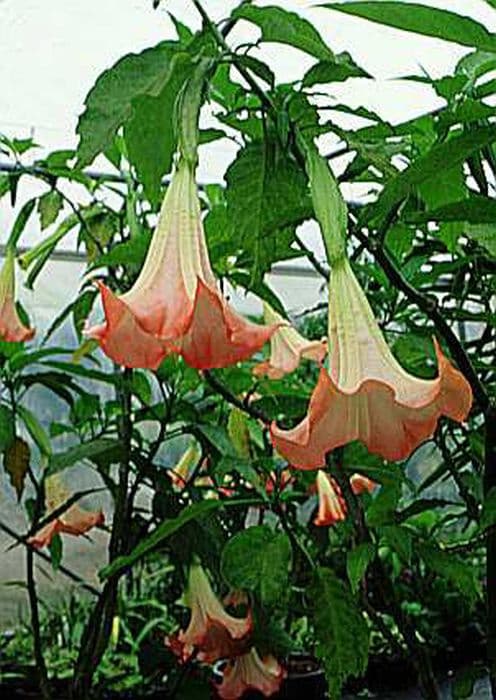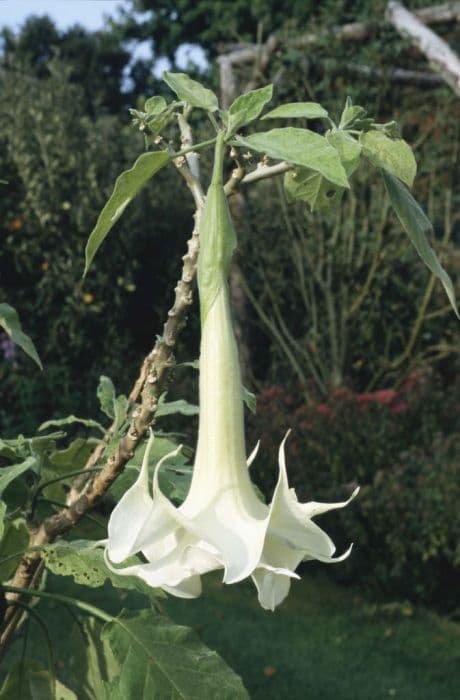Petunia Petunia × atkinsiana Tidal Wave Series, mixed

ABOUT
The Tidal Wave Series of Petunias are known for their vibrant and colorful display. These plants have large, funnel-shaped flowers which come in a mix of striking colors including shades of pink, purple, red, and white, often with distinct veining or color patterns that add to their visual appeal. The petals can be solid or patterned with contrasting hues and are known for their soft, velvety texture. The plant's foliage comprises green, oval-shaped leaves that provide a lush background for the profusion of blossoms. These petunias tend to exhibit a spreading habit, creating a blanket of color that flows and fills the space with a dynamic and striking display. The blossoms' sweet and pleasant fragrance adds another layer to their allure, making them a favorite among gardeners for both sensory and aesthetic contributions to gardens and landscapes.
About this plant
 Names
NamesFamily
Solanaceae.
Synonyms
Spreading Petunia, Wave Petunia, Tidal Wave Petunia, Hybrid Petunia.
Common names
Petunia × hybrida Tidal Wave Series, mixed.
 Toxicity
ToxicityTo humans
Petunias are generally considered non-toxic to humans. If ingested in large quantities, like many plants, they could potentially cause mild gastrointestinal upset, but they are not known to cause serious harm or poisoning.
To pets
Petunias are generally recognized as non-toxic to dogs, cats, and other household pets. They are not known to contain any toxic principles that would lead to poisoning. Ingestion of petunias might occasionally result in mild digestive discomfort, but they are not considered poisonous to pets.
 Characteristics
CharacteristicsLife cycle
Annuals
Foliage type
Deciduous
Color of leaves
Green
Flower color
Mixed
Height
1-2 feet (30-61 cm)
Spread
2-3 feet (61-91 cm)
Plant type
Herb
Hardiness zones
9-11
Native area
South America
Benefits
 General Benefits
General Benefits- Visual Appeal: Offers a wide range of bright and vibrant colors, enhancing the aesthetic of gardens and landscapes.
- Easy to Grow: Known for being low-maintenance, making it suitable for gardeners of all skill levels.
- Versatility: Can be grown in a variety of settings including borders, beds, hanging baskets, and containers.
- Rapid Growth: Fills in garden spaces quickly due to its fast growth habit, providing immediate results.
- Pest Resistance: Shows a good degree of resistance to common garden pests, reducing the need for chemical treatments.
- Drought Tolerance: Once established, can tolerate periods of dry weather, limiting the need for frequent watering.
- Continuous Blooming: Produces flowers continuously throughout the growing season, ensuring lasting color in the garden.
- Pollinator Attraction: Attracts beneficial pollinators like bees and butterflies, supporting local ecosystems.
 Medical Properties
Medical PropertiesThis plant is not used for medical purposes.
 Air-purifying Qualities
Air-purifying QualitiesThis plant is not specifically known for air purifying qualities.
 Other Uses
Other Uses- Edible Decoration: Petunia petals are edible and can be used to decorate salads and desserts for a splash of color and a mild flavor.
- Education and Research: Petunias are often used in genetic studies due to their wide variety of colors and patterns, offering insight into plant genetics and hybridization.
- Ink and Dye: The vibrant colors of petunias can be extracted to create natural dyes for textiles or inks for art projects.
- Photography: Petunias, with their bright and varied colors, provide excellent subjects for macro photography and garden portfolios.
- Ice Cubes: Freeze petals in ice cubes for a decorative touch in summertime drinks or punch bowls.
- Homemade Potpourri: Dried petunia petals can be added to potpourri mixes for a light, floral scent and to enhance visual appeal.
- Petal Confetti: Dry and crush petunia petals to create biodegradable confetti for weddings or other celebrations.
- Companion Planting: Petunias can be planted alongside vegetables to help deter pests with their strong scent.
- Craft Projects: Pressed petunia flowers can be used in crafting, such as in making bookmarks, greeting cards, or decoupaged items.
- Scented Candles: Incorporate petunia petals or essential oils derived from the flowers into candle making for a subtly scented product.
Interesting Facts
 Feng Shui
Feng ShuiThe Petunias are not used in Feng Shui practice.
 Zodiac Sign Compitability
Zodiac Sign CompitabilityThe Petunias are not used in astrology practice.
 Plant Symbolism
Plant Symbolism- Anger and Resentment: In some traditions, petunias are associated with feelings of anger and resentment, perhaps because they can thrive in challenging conditions.
- Desire: Petunias can symbolize a longing or desire for the company of another, representing the human need for companionship and affection.
- Soothing Presence: The presence of petunias is often seen as comforting, bringing a sense of calm and tranquility to a space.
- Motherly Love: The nurturing way that petunias envelop their environment may be reminiscent of a mother's love, embracing and protecting those who are near.
 Water
WaterWave Petunias should be watered regularly to keep the soil moist but not soggy. During hot weather, this might mean watering daily, especially for petunias in containers which dry out faster. Provide about one inch of water per week, adjusting as necessary during periods of rainfall or drought. The method of watering should be at the base of the plant to avoid wetting the foliage, which can lead to fungal diseases; a soaker hose is ideal for this purpose. In containers, water thoroughly until water runs out the drainage holes; this might equate to roughly half a gallon for a standard hanging basket every other day during peak summer temperatures but will vary with the size of the container and plant.
 Light
LightTidal Wave Petunias thrive in full sun, which means they need at least six to eight hours of direct sunlight a day. They perform best when planted in a spot that receives morning sunlight, which is less intense and helps dry dew on the leaves, reducing the chance of disease. However, they can also tolerate partial sun, which means they'll still grow with a minimum of four hours of direct sunlight, but blooming might be reduced.
 Temperature
TemperaturePetunias prefer warm conditions and do best in temperatures ranging between 60 and 80 degrees Fahrenheit. They can tolerate a slight chill and survive brief periods in temperatures as low as 40 degrees Fahrenheit, but frost is detrimental to petunias. Conversely, temperatures above 90 degrees Fahrenheit might stress the plants and cause blooming to taper off. The ideal growth temperature will keep the petunias healthy and blooming profusely.
 Pruning
PruningPruning Wave Petunias is essential for preventing legginess and encouraging bushier growth with more blooms. Pinch back the tips of the stems every few weeks to promote branching. The best time to start pruning is when the plants are young, as this helps to establish a fuller habit from the outset. Regular deadheading of spent flowers will also encourage the plant to produce new blooms. Pruning is generally not needed in the fall as the plants will die back with the first frost.
 Cleaning
CleaningAs needed
 Soil
SoilPetunias thrive in well-draining, fertile soil with a pH range of 6.0 to 7.0. A best soil mix for petunias, such as the Tidal Wave series, contains a balanced blend of peat moss, perlite or vermiculite, and compost or well-rotted manure to provide nutrients and improve aeration and moisture retention.
 Repotting
RepottingTidal Wave petunias typically don't need repotting as they are often grown as annuals. However, if they are kept in containers and brought indoors, repot them every spring to refresh the soil and accommodate root growth.
 Humidity & Misting
Humidity & MistingPetunias, including the Tidal Wave series, prefer moderate humidity levels. They do well in the typical range of outdoor humidity but can tolerate some dry air. Avoid overly humid conditions which can lead to fungal diseases.
 Suitable locations
Suitable locationsIndoor
Provide bright light, well-draining soil, and moderate water.
Outdoor
Place in full sun, well-draining soil, and deadhead regularly.
Hardiness zone
9-11 USDA
 Life cycle
Life cycleThe life of the Tidal Wave Petunia begins with seed germination, which occurs when the temperature is consistently warm, typically in the spring after the danger of frost has passed. As seedlings emerge and grow, they develop a root system and foliage through the vegetative stage. Flowering ensues as the plants mature, characterized by a profusion of vibrant, colorful blooms that can last from late spring until the first frost of fall. Throughout the flowering phase, the petunias continuously produce new blooms while old flowers fade and can be deadheaded to encourage further flowering. As temperatures drop in autumn, flowering diminishes, growth slows down, and the petunias eventually die back with the onset of frost if they are treated as annuals. However, in some climates, they can survive the winter and re-sprout in the following spring if conditions permit.
 Propogation
PropogationPropogation time
Spring to early Summer
Petunia × atkinsiana Tidal Wave Series, commonly known as Tidal Wave Petunia, is typically propagated through seed since they are hybrid plants. The most popular method is sowing seeds indoors about 8 to 10 weeks before the last frost date. Using a seed-starting tray filled with a well-draining soil mix, seeds are scattered on the soil surface and gently pressed into the soil, as petunia seeds need light to germinate. The tray should then be covered with a plastic dome or wrap to maintain humidity. It's crucial to place the tray in a bright spot with temperatures between 70 to 80 degrees Fahrenheit (21 to 27 degrees Celsius) and to keep the soil evenly moist until seeds germinate, usually within 7 to 14 days. After germination, it's important to remove the cover and continue providing abundant light to the seedlings until they are strong enough to be transplanted outdoors after the risk of frost has passed.


![Calibrachoa [Aloha Classic Blue Sky]](/_next/image?url=https%3A%2F%2Fplants-admin.emdemapps.com%2Fimages%2Fplants%2F%2Fimages%2F604b636c3778b.png&w=640&q=75)
![Calibrachoa [Aloha Classic Gold]](/_next/image?url=https%3A%2F%2Fplants-admin.emdemapps.com%2Fimages%2Fplants%2F%2Fimages%2F604b6284c573e.png&w=640&q=75)
![Calibrachoa [Aloha Classic Tiki Soft Pink]](/_next/image?url=https%3A%2F%2Fplants-admin.emdemapps.com%2Fimages%2Fplants%2F%2Fimages%2F604b548e0a5ef.png&w=640&q=75)
![Calibrachoa [Cabaret Deep Yellow]](/_next/image?url=https%3A%2F%2Fplants-admin.emdemapps.com%2Fimages%2Fplants%2F%2Fimages%2F604b5f20ca3ef.png&w=640&q=75)
![Calibrachoa [Calibasket Radiant Orange]](/_next/image?url=https%3A%2F%2Fplants-admin.emdemapps.com%2Fimages%2Fplants%2F%2Fimages%2F604b536d43cb2.png&w=640&q=75)
![Calibrachoa [Caloha Classic Blue Velvet]](/_next/image?url=https%3A%2F%2Fplants-admin.emdemapps.com%2Fimages%2Fplants%2F%2Fimages%2F604b604884a75.png&w=640&q=75)
![Calibrachoa [Caloha Classic Honey White]](/_next/image?url=https%3A%2F%2Fplants-admin.emdemapps.com%2Fimages%2Fplants%2F%2Fimages%2F604b5f56e0beb.png&w=640&q=75)
![Calibrachoa [Caloha Classic Yellow Chocolate Ring]](/_next/image?url=https%3A%2F%2Fplants-admin.emdemapps.com%2Fimages%2Fplants%2F%2Fimages%2F604b538aede95.png&w=640&q=75)